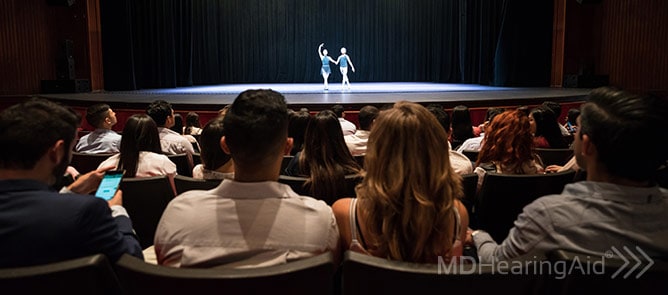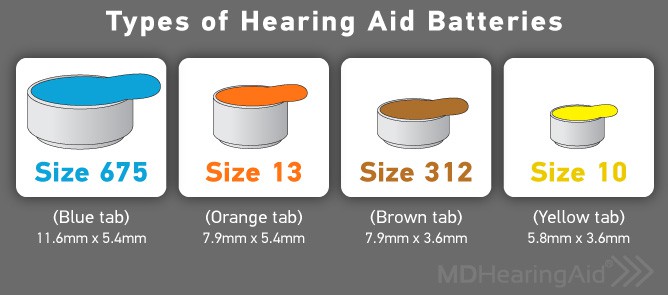Now that we’ve covered where you can buy hearing aids and the types of hearing aids, it’s time to cover some common hearing aid features. You don’t want to buy an expensive hearing aid without understanding what the features even do, because then you’re likely never going to use those features. And, you don’t want to buy the cheapest, simplest hearing aid without knowing the useful features you might be missing out on. You should pay for a hearing aid with features you need. Here are some of the big hearing aid features you’ll see advertised today.
Noise and Feedback Reduction
If you have hearing loss, it’s easy to forget how loud the world actually is. When you start wearing hearing aids, some background sounds (water running in your faucet, newspaper crinkling) can feel overly loud and hard to ignore. Modern digital hearing aid technology now utilizes noise reduction to help you focus on what you want to hear—other people.
As with most technology, the better the digital noise reduction technology in a hearing aid, the more the hearing aid will cost. If you mostly find yourself in quieter situations, like staying in with your sweetie or watching television, noise and feedback reduction might not be your highest priority when researching hearing aid features. If you frequently find yourself in high noise environments like loud restaurants, the added cost of top-of-the-line noise reduction might be more worth it for you.
For long time hearing aid users, one of the biggest complaints about older hearing aid models is feedback, that annoying whistling noise that can seemingly come from nowhere. Because the microphone and receiver are so close to each other, hearing aids are especially prone to feedback. It’s most likely to happen when something moves close to your hearing aid, whether you’re putting on a hat or hugging a friend. Luckily, new technology means many digital hearing aids (including all of MDHearing’s digital hearing aids) have feedback reduction built in.
Adaptive Technology
Some hearing aids are able to automatically and intelligently adjust your settings when it senses you’ve moved from a loud environment to a quieter one (or vice versa). Walking into a loud room while still having your hearing aids set to pick up more sounds can be overwhelming and unnerving — adaptive technology helps you avoid this. Adaptive technology also means less work on your part to fiddle with settings and adjust your hearing aid volume every time you leave a room.
Another aspect of adaptive hearing aid technology is the dual directional microphone feature. Dual directional hearing aid microphones automatically adjust sound levels depending on your surroundings. Directional microphones are the only clinically proven way to improve hearing in noisy situations. Instead of all sounds (including background noise) being amplified, only specific types of sounds are. For instance, directional microphones will hone in on the sounds directly in front of you. This feature is perfect for hearing aid users who live in noisy cities, go to large church services, or enjoy outings with friends.
Not all hearing aids have dual directional microphones, but they’re becoming more and more popular with MDHearing customers for a reason.
Multiple Programs
Another feature you’ll hear about a lot when researching your options is hearing aid programs. Think about a car radio that lets you set favorite channels so you don’t have to fiddle with the frequency. Hearing aid programs are similar. Just turn on the program you want and your hearing aid will adjust the microphone, gain, and frequency response instantly.
Hearing aid programs are a good feature for users who know they’ll be using their hearing aids in different settings. Many hearing aids come with already set programs specifically designed for different environments, like busy restaurants, quiet nights at home, or the great outdoors. Understanding the program options for the devices you’re researching can help you pick out the right hearing aid for your lifestyle.
Maximum Gain
Many hearing aid companies will advertise what level of hearing loss their hearing aids are intended to assist, often in a ranges like mild to moderate. Sometimes they’ll reference the hearing aid’s maximum gain in decibels, which is how much the hearing aid can amplify incoming sounds to help you hear them.
Generally, the higher maximum gain, the more expensive the hearing aid is going to be. If you only have mild hearing loss, you won’t be getting any extra benefit from buying the world’s loudest hearing aid, since increasing the volume beyond what you need won’t benefit your hearing. But, if you have severe hearing loss, you should be looking for a hearing aid that is strong enough for you to hear.
We strongly suggest you get a hearing test done by a professional before buying a hearing aid, even if you are purchasing online or over the phone with us. Getting your hearing tested will give you a wealth of information about your particular hearing, including the level of hearing loss you have–mild, moderate, or severe. And, if you’ve completed a hearing test, MDHearing’s hearing specialists will be happy to review your results and tell you if our hearing aids’ maximum gain levels will work for your hearing loss.
Waterproof Hearing Aids
Waterproof hearing aids, which use a silicone seal to encase the hearing aid body, can seem really appealing at first. After all, many people worry about moisture issues when it comes to their hearing aids. But unless you’re determined to keep your hearing aids in when you go swimming, they may not be worth it.
Keep in mind that there’s a wide scale when it comes to waterproof (or simply water-resistant) hearing aids. Even if a hearing aid claims to be waterproof, it might not be completely safe from moisture. The key is to look for the IPX rating. The higher the IPX rating, the more protected it is from water and moisture (the highest a hearing aid has gotten is IPX7). Lower IPX ratings will just protect against condensation and light water splashing.
Even with high IPX ratings, carefully read the user manual about underwater use — most companies recommend avoiding submersion for extended periods of time, even for high IPX rated models.
And then there’s the price. Waterproofing is one of the more expensive add-on hearing aid features. It’s not even your only option for keeping your hearing aids dry; a UV clean and dry box is a fraction of the price and takes care of many moisture issues a hearing aid user faces. The question is, are you doing enough activities around water or humidity that you feel the price increase is worth it for the waterproofing?
Telecoil
Telecoil (or t-coil) technology works like a wireless antenna, linking up to a sound system and streaming the sound directly to your ears, without any background noise. Hearing aids with a telecoil can help you hear a phone call or the TV better (as long as the phone or television is telecoil compatible). This feature is helpful outside the home as well, linking up to compatible sound systems in amphitheaters, concert halls, or even church.
Rechargeable Batteries
Some hearing aid manufacturers are taking a cue from cell phones and creating rechargeable batteries (either in silver-zinc or lithium-ion) so that the hearing aid is simply plugged into a charger. Hearing aid users with dexterity issues can appreciate not having to replace the small disposable batteries by hand. They also don’t have to bother with buying disposable batteries.
There are issues with both kinds of rechargeable hearing aid batteries, though. Lithium-ion batteries can be dangerous; there’s a risk of lithium-ion batteries catching on fire if your hearing aids have collected moisture or are otherwise damaged. Outside of the fire hazard, lithium-ion batteries are also larger and therefore can only be put in larger, more noticeable, and less visually appealing hearing aids. When the battery does eventually die completely, you’ll need to have the manufacturer replace it themselves, and that can get expensive. Silver-zinc rechargeable hearing aid batteries are a little more stable and safer than lithium-ion batteries. That said, silver-zinc batteries need to be replaced more often.
Also be aware that some rechargeable batteries still need to be taken out to recharge. Some of these hearing aids only use rechargeable batteries, meaning you’ll need to keep an extra rechargeable battery on hand if you don’t want to wait.
Battery Sizes
There are four main types of hearing aid battery sizes: 675, 13, 312, and 10.
Battery sizes tend to correlate with the size of the hearing aid itself. 675 sized batteries have the best battery life and tend to be the easiest to put in by hand, but because they’re so big, they’re only used in the larger, most noticeable hearing aid models.
On the other end of the spectrum, in-the-ear hearing aids are small and discreet, but that means they have to use the very small size 10 battery. Size 10 batteries can be difficult to handle for those with dexterity issues. And because they have a shorter battery life, they also have to be replaced more often.
MDHearing’s battery sizes are in the middle of the group. The PRO and AIR use size 13. The CORE has a slightly smaller, size 312 battery.
Types of Controls
There are a variety of types of controls on hearing aids. Some have a rocker switch, some have volume dials, some have buttons, and some utilize a separate a remote control. What works best for you will largely depend on your dexterity in your fingers. Tiny rocker switch controls are great for people who want the least noticeable hearing aid. People with dexterity issues may prefer separate buttons, an easy-to-use volume dial, or even a larger remote control.
Think about your other devices and what types of controls feel the easiest to use, then look for those kinds of controls as you’re researching hearing aids.
Bluetooth Hearing Aid Technology
One of the newest and most exciting hearing aid features is wireless Bluetooth technology. By using the Bluetooth tech already in your smartphone, certain hearing aids allow you to control your settings right from your phone, just like a remote control. Hearing aid users with dexterity problems benefit from being able to adjust their hearing aids without needing to fiddle with the small controls on the hearing aid itself.
The MDHearing CORE takes this one step further. The MDHearing app creates a personal profile for you based on your response to a series of tones, and then optimizes the settings for your specific hearing. You can completely avoid the numerous trips to the hearing clinic to get your hearing aid programmed or adjusted — just do it from the comfort of your home!
Biggest Rule: Choose Hearing Aid Features that Work for You
The truth is, there is no one perfect hearing aid. Even if a hearing aid is boasting the most special features, that does not mean it’s necessarily the best fit for your lifestyle or your budget. As you’re researching, think about the specific hearing aid features that will help you hear best and make you the most comfortable. Those are the features worth investing in.
Next in our Hearing Aid Buyer’s Guide: ordering your hearing aids… and what comes next.
READ THE FINAL CHAPTER



